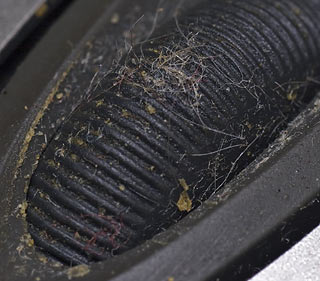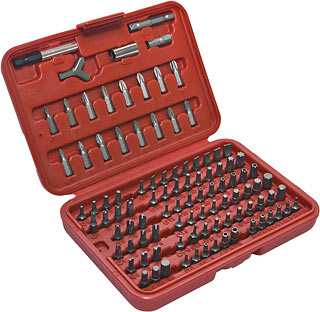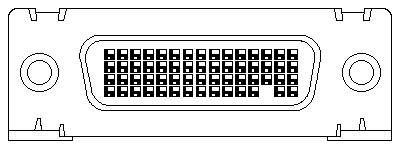
Atomic I/O letters column #100
Originally published 2009, in Atomic: Maximum Power ComputingReprinted here February 3, 2010 Last modified 16-Jan-2015.
You'll need a microscope, and a very small compass...
Recently, I got distracted while setting up gear at a LAN party, and plugged the 4-pin power connector from my Philips IDE enclosure into my X-Craft one. The light came on rather dim, and a high-pitched noise came from the hard drive. I immediately shut it off, and noticed the smell of burning electronics coming from the enclosure.
Furthermore, I then found that I forgot to bring the real adapter for that enclosure. Someone else offered to plug the drive into their PC to test it, and smoke rose from the circuit board of the drive when it was attached.
The enclosure, however, does work with another drive in it, which is a little unexpected. I looked at the power supply I used, and the one that came with the drive, and basically, they have the 12 and 5V pins reversed with regards to each other. Why can't manufacturers just agree?
I presume at this point, the drive is dead. Of course, as things go, there was some un-backed-up data on there that I'd like back. I believe that the drive/platters/heads are all still fine, it's just the controller board on the bottom of the drive that is fried since all the 5V electronics received a rather unwanted 12. I take it that I'd need to search for a drive that is the exact same model, revision and capacity (it's a Samsung HD753LJ RevA 750GB) in order to do this? Or can I be less exact? Do you have experience or any tips with this sort of thing?
Geordie
Answer:
I think more computer failures should involve smoke. If you've got to have some
hardware crap out on you, it at least ought to do it in style.
There are several ways in which this precise symptom-set could arise. If I were guessing, I'd say the original connecting of the wrong power supply caused some regulator or chip to fail into a power-pin short-circuit, then the PC's beefier power supply cheerfully gave that component 25 amps or whatever to complete its destruction.
It's likely that most or all of the data on the drive's platters is A-OK, and slightly less likely that the drive remains mechanically functional. It wouldn't surprise me if the motor or heads have been barbecued. I also wouldn't be surprised if a new controller board revived it, though.
Controller-board swaps are, however, a painful process. It's usually quite easy to actually swap the boards (remember to take anti-static precautions; ESD-discharging wrist straps cost almost nothing). It's getting the right board that's the tricky bit.
As you say, you'll need to find not just the right model of drive, but also the same "stepping" and/or firmware revision, which you can probably figure out by looking at the old drive. (A later firmware may also work; an earlier one probably won't.) You shouldn't expect a board-swapped drive to be reliable; bad-block mapping and other low-level voodoo may be messed up, so you should just read the data you need off it and then consign it to the grave.
On the plus side, if you get a board-donor drive and the board doesn't work, you should be able to swap it back onto the donor and thus still have a new, blank drive. But the whole process is unlikely to be worth the effort unless the un-backed-up data on the old drive is very important.
You just can't toilet-train 'em
I would like you and your great big brain to explain something that has had me bewildered for many many years. Mouse-poo on the mouse pad.
Whatever the surface, it always appears after some time - smooth round blobs of excrement on the mouse pad, and on the "feet" of my optical mouse. Where do mouses poo from?
I am forever scraping this poo off my mouse pad in a vain attempt to maintain a level of hygiene in the workplace.
Liam

You can really taste the sebum!
Answer:
The stuff that accumulates on mouse feet, and also in mouse-wheel grooves and the
seams of mouse casings, is your very own creation. If you doubt me, take it for DNA
profiling.
If you sit in a chair and are careful to avoid moving at all, you may shed as few as 100,000 flakes of dead skin per minute. Usually, humans shed millions per minute. If you're using some tool, like a mouse, shed skin from your hand will combine with sweat and the oily "sebum" that keeps your skin flexible to make a concoction dubbed "hand salsa" by FPS gamers. And if you leave hand salsa to dry out it becomes a gooey mass, which accumulates in various places.
Count yourself lucky that the stuff at least doesn't stop mice from working any more. The rollers of opto-mechanical mice always used to cake up with delicious little doughnuts of fibre-reinforced hand salsa.
If you want to avoid blobs of crud building up ion your mouse-mat, get one with a more pronounced texture. That'll keep the accumulating crud in the valleys between the texture-bumps.
Until, of course, you fill the valleys up!
Pins 1 through 5: IBM MDA output
I've recently got a second PC from a advertising agency that has just gone under. On this PC it has a strange display port, which I thought was a DVI but when I looked closer it's not:
Do you know what it is? I would like to buy an adapter for it.
James
Answer:
It's a DMS-59 connector.
And yes, you ought to be able to plug standard monitors into it with an adapter cable. There should be two DVI outputs on that one connector, and possibly also two analogue "VGA" outputs, but I'm not certain. Most DMS-59 adapters (which shouldn't cost more than about $AU20) are Y-shaped, with two DVI or two VGA connectors, but the analogue video obviously won't work if the card doesn't actually connect those pins to anything.
Or just Dremel the heads off
I was trying to find out how to take apart a seemingly impenetrable hard disk drive to remove the magnets and came upon your (very long) discourse on magnets, the universe and everything. Though almost none of it was comprehensible to me (my fault, not yours) I found myself reading to the end because your style was interesting.
Jackie

The only screws that do not fear a big set of hex bits are ones that cower in
narrow holes.
Answer:
Presuming you still want to get into the drive, as I mention at some point in that
lengthy piece, you'll probably need a set of "Torx"
or "star" screwdrivers; many hard drives (and some other things, like mobile phones)
are held together with star screws. You can use hex "Allen
keys" in a pinch to remove these screws, but proper Torx drivers work better.
Because hard drives don't have any screws at the bottom of narrow casing holes, you can use cheap quarter-inch hex bits instead of one-piece drivers. But the screws may be too small for any hex bits you can easily buy.
The big hundred-piece bit set in the picture above is a $AU19.95 Jaycar product, catalogue number TD2038. There are lots of other options, too. (I know nothing about those particular Amazon sellers - they were just the first Amazon hits.)
Note that some drives are held together by things other than screws. In the magnets piece, I mention one that was basically just sticky-taped together, with aluminium tape around the seam.
It's definitely worth the effort to get in there, though. Even if you don't care about the lovely precision fasteners and bearings and brushless motor, there are still the pretty platters, the amazingly precise head assembly, and of course the magnets.
Try a few hundred write-protected C64 tapes!
As a computer tech, I carry the obligatory folder-full-o-CD-Rs for when some computer needs the application of a specialized utility to set it right - or just when I don't feel like downloading all of it over again. The trouble is that every so often I come across a computer whose CD drive is broken, flaky, or just never existed. However, they all have USB ports, so I've got a USB stick loaded up for them. My question is twofold:
A: how much should I worry about nasty virus-like things jumping onto my thumb drive when I plug it in? and
B: Are there any thumb drives you're aware of with a write-protection feature to prevent that absolutely?
Ben
Answer:
The bulky solution to this problem is an external CD/DVD drive. You can even get
USB CD/DVD drives that don't need an external power brick. It's still not very elegant,
though.
I don't think it's very likely that your USB drive will be infected with anything, but it's certainly possible. If your own computers don't have auto-run stuff turned on then you needn't worry about anything spreading to your systems, but Joe Average's computer has AutoRun turned on for every possible drive, and there certainly is malware that takes advantage of that. I don't think this is a common malware feature, though.
There are flash drives with write-protect as standard, but I think many of them do it with some cockamamie software utility. I haven't really looked into this since a 16Mb drive cost sixty bucks, though, so there's probably some good option out there with a proper hardware switch.
Personally, though, I'd do this a different way. Just get an SD card and a slimline reader for it. Cheap, small, and it's got a standardised write-protect system.
I haven't done an exhaustive survey, but I think every SD reader has the little leaf-switch arrangement up the side of the slot that senses the tiny sliding write-protect tab on the cards. I've got a few different microSD-to-full-SD adapters here, too, and they've all got the tab, which makes them properly unwritable in two different readers I've tried. MicroSD cards themselves don't have the tab, though; you have to adapt them up to full-SD size.
As with floppy disks in days of yore, the SD write protect system works by mechanical engagement of a physical switch. So it's probably quite easy to open up an SD-card reader and modify it with a bit of tape or glue to regard all cards as write-protected. Or as write-enabled, for that matter.
UPDATE: After this page went up, a couple of readers pointed out to me that the SD-card write-protect tab is not a perfect write-prevention device, because it only works with the consent of the controller and the driver software. It's perfectly possible to make software that can write to a write-protected card.
(Some software does odd things with the write-protect setting. The CHDK replacement digital-camera firmware, with which you can make a variety of point-and-shoot digicams do all sorts of odd things, uses the write-protect bit to signal the camera to boot from the SD card, and is then perfectly happy to write pictures to it even though the write-protect tab is still on.)
One reader also pointed out that it's possible to buy cheap off-brand MP3 players, like this modernised version of the ones I reviewed years ago, that have a hardware write-protect switch on them. It's the same "HOLD" switch that locks the control buttons so you don't press them accidentally.
Another couple of readers recommend the PQI U339 thumb drive, which has a non-bypassable hardware write-protect switch on the end of it. One of them mentioned "it's a unique thrill to plug one into a virus-infested PC and watch all the 'Access denied - please enable write protect on this drive and try again' messages pop up"!
(Australian readers can, as of February 2010, pick up a 4Gb U339 from m'verygoodfriends at Aus PC Market for $AU39.60 delivered - click here to order! That price would be something of a rip-off if this were a generic USB stick, but the write-protect switch is a valuable feature.)


